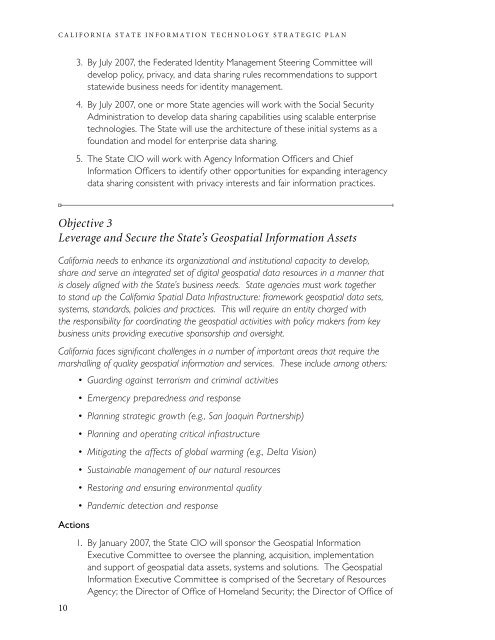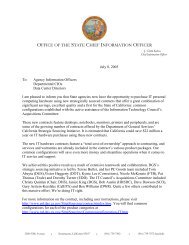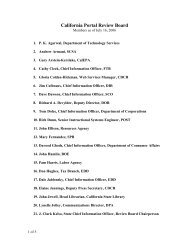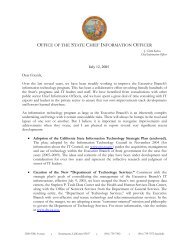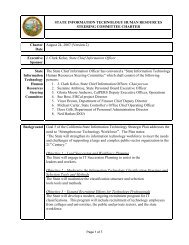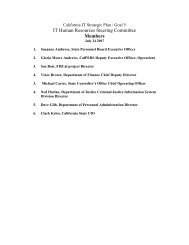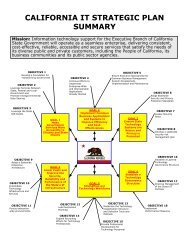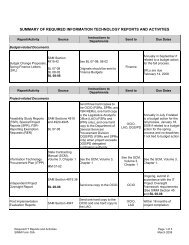Strategic Plan (PDF) - Cioarchives.ca.gov - State of California
Strategic Plan (PDF) - Cioarchives.ca.gov - State of California
Strategic Plan (PDF) - Cioarchives.ca.gov - State of California
You also want an ePaper? Increase the reach of your titles
YUMPU automatically turns print PDFs into web optimized ePapers that Google loves.
CALIFORNIA STATE INFORMATION TECHNOLOGY STRATEGIC PLAN3. By July 2007, the Federated Identity Management Steering Committee willdevelop policy, privacy, and data sharing rules recommendations to supportstatewide business needs for identity management.4. By July 2007, one or more <strong>State</strong> agencies will work with the Social SecurityAdministration to develop data sharing <strong>ca</strong>pabilities using s<strong>ca</strong>lable enterprisetechnologies. The <strong>State</strong> will use the architecture <strong>of</strong> these initial systems as afoundation and model for enterprise data sharing.5. The <strong>State</strong> CIO will work with Agency Information Offi cers and ChiefInformation Offi cers to identify other opportunities for expanding interagencydata sharing consistent with privacy interests and fair information practices.Objective 3Leverage and Secure the <strong>State</strong>’s Geospatial Information Assets<strong>California</strong> needs to enhance its organizational and institutional <strong>ca</strong>pacity to develop,share and serve an integrated set <strong>of</strong> digital geospatial data resources in a manner thatis closely aligned with the <strong>State</strong>’s business needs. <strong>State</strong> agencies must work togetherto stand up the <strong>California</strong> Spatial Data Infrastructure: framework geospatial data sets,systems, standards, policies and practices. This will require an entity charged withthe responsibility for coordinating the geospatial activities with policy makers from keybusiness units providing executive sponsorship and oversight.<strong>California</strong> faces signifi <strong>ca</strong>nt challenges in a number <strong>of</strong> important areas that require themarshalling <strong>of</strong> quality geospatial information and services. These include among others:• Guarding against terrorism and criminal activitiesActions• Emergency preparedness and response• <strong>Plan</strong>ning strategic growth (e.g., San Joaquin Partnership)• <strong>Plan</strong>ning and operating criti<strong>ca</strong>l infrastructure• Mitigating the affects <strong>of</strong> global warming (e.g., Delta Vision)• Sustainable management <strong>of</strong> our natural resources• Restoring and ensuring environmental quality• Pandemic detection and response101. By January 2007, the <strong>State</strong> CIO will sponsor the Geospatial InformationExecutive Committee to oversee the planning, acquisition, implementationand support <strong>of</strong> geospatial data assets, systems and solutions. The GeospatialInformation Executive Committee is comprised <strong>of</strong> the Secretary <strong>of</strong> ResourcesAgency; the Director <strong>of</strong> Offi ce <strong>of</strong> Homeland Security; the Director <strong>of</strong> Offi ce <strong>of</strong>


